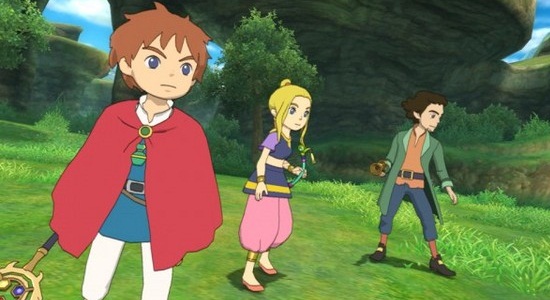Ni no Kuni will come out this January in North America and Europe. I’ve noticed a lot of people don’t know much about the game, though, so here’s a helpful FAQ. If you have a question of your own, feel free to ask in the comments.
Q: Is this game easy?
A: Overall, no. It has easy parts and hard parts. Most of the first 15 hours will be very easy for seasoned gamers who have played RPGs for 20 years, yes. But after a while, you’ll find that there are some very big challenges in Ni no Kuni‘s boss fights and even random encounters. If you move at a normal pace through the story, the difficulty will be hover around a moderate level.
The thing is, however, that Ni no Kuni‘s battle system is really fun once you get a variety of characters and abilities (as do your opponents), and there is a hell of a lot to do between all the quests and monster hunting, so a lot of people might find themselves unintentionally “grinding.” I hesitate to use that term, though, because the battle system being fun makes it not a “grind” by definition. “Grinding” more applies to battles that you fight because you seriously can’t advance to the next story section without getting slaughtered — you don’t want to fight them, but feel you must.
If you’re overleveled or if you’re anywhere before the second or third town? Yes, it’s pretty easy. Once you’ve got multiple party members? Oh hell no, stuff gets real. Your first battles on the water (after you get the ship) will demonstrate a quick step up in difficulty.
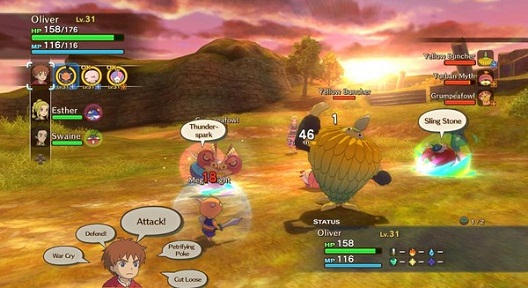
Q: How do you get into battle? Random encounters?
A: In dungeons and on the overworld map, the player can see all enemies (unless they’re hiding in the forest). If they’re strong enough to be confident against you, they’ll charge once they’re within draw distance. Sometimes, however, weak enemies will spot Oliver and run away. It’s a subtle hint from the game that, hey, you’re almost too strong for this area, wink wink, nudge nudge.
Q: Is this game too kiddy?
A: That depends on you. If you’re an adult who is confident in your maturity level, then no, it isn’t too kiddy. If you have insecurities about your own maturity level, then maybe it is too kiddy for you (or the other way around).
There is a strong difference between mature content and mature themes, and there is a big difference between something being childlike and being childish. The inclusion of handguns, the F word, and breasts does not make a game “mature.” This is a fallacy created by the ESRB rating system which brands a game containing such things as “Mature.” The lack of logic in that naming can be found underneath the giant M, where the label says “17+,” meaning 17-year-olds can buy these games. We all know that 17-year-olds are the least mature creatures on the face of the planet.
Ni no Kuni stars a young boy in colorful world populated by cute monsters, so it will inevitably be mislabeled as a “kids’ game” by some. There’s a difference between content being appropriate for the whole family and content being specifically targeted at children, though, and Ni no Kuni is a game truly enjoyable adults in the same way that Studio Ghibli’s best movies are truly mystifying to all age groups. In fact, Famitsu’s review said (and I agree) that the difficulty of this game might be a little too high for the kids that might be drawn in by the art style.
Q: I’ve heard the battle system is like Final Fantasy XII? Is that true?
A: No, though I can see where people get that idea. Both have battles furiously raging on while the characters can move freely, so it does look visually similar. In Final Fantasy XII, moving around had very little effect on your chances of getting hit, whereas in Ni no Kuni, a character can run laps around the battlefield while an opponent is unable to land a hit. Of course, sooner or later, you’ll have to actually do something from a menu, but the point is, temporary survival can come from use of distance, which was an extreme rarity in FFXII. I remember running from enemies only to be getting “hit” in the back as I did so.
Final Fantasy XII‘s Gambit system allowed players to be specific about what they wanted characters to do at what times, while Ni no Kuni only offers a very vague set of A.I. management settings.
More importantly, the flow of battle is entirely different. Final Fantasy XII had its characters with their license boards and such, but Ni no Kuni has humans who control monsters. It’s tough to explain every single difference, but let’s simplify it to this: playing Ni no Kuni doesn’t feel anything like playing Final Fantasy XII. Where playing Bejeweled gives you an advantage in understanding Puzzle Quest, playing FFXII will not make you understand Ni no Kuni any better.
Q: Is the monster catching like Pokémon?
A: Only in the sense that you catch monsters. If catching monsters makes things inherently like Pokémon, then I guess so, but the mechanics of catching the monsters and process of raising said monsters are handled very differently in Ni no Kuni. For more on Pokémon comparisons, see the section below the rest of the questions.
Q: How is EXP handled?
A: EXP given at the end of the fight is received by all human characters (starting with one, but reaching three about one-third of the way through the story main story) and all monsters that they have. Since each human can bring three monsters into battle, this means up to nine monsters can get EXP for each fight. The points are given straight up in a static amount (not divided), to all participants, regardless of their status or HP at the end of the fight. This might sound too generous to the uninitiated, but trust me, with how many monsters you’ll be wanting to improve, you’ll be glad this system is in place.
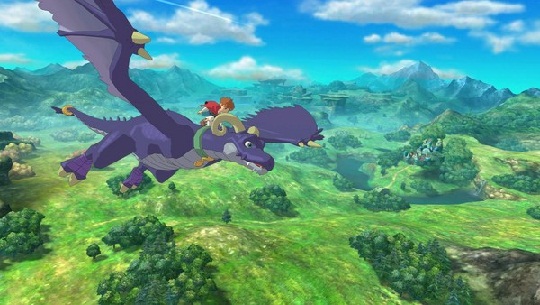
Q: How does crafting work?
A: What one might call “vanilla.” You put items in your alchemy pot and see what happens. If the chosen items can’t be combined, then you don’t lose your stuff. After you get the alchemy pot, you can also get a recipe book from a nearby quest, but it’ll take most people some time to be able to fulfill that quest. This book won’t be complete, however, and you’ll need to get other ones from NPCs in future towns.
What I don’t like about it is that you can’t double the quantities to make double the items unless you have the recipe, and getting that recipe is often difficult and/or time-consuming. If you want three juicy sandwiches — made with one bread and one soft beef — then you have to add the ingredients over and over and over, manually, for every single one you craft, until you get the recipe. I know what you’re thinking: “Doesn’t it save the recipe after you successfully craft something?” The answer is no, it doesn’t. This really should have been solved with a simple algorithm.
Q: Are battles turn-based, action style, or real-time menu based?
A: Some portion of all of those.
When deciding to attack, escape, defend, or use another type of skill, time marches on and combatants will be punching each other in the face. When controlling a human in battle (instead of a monster) and selecting which of their spells or items to use, time stops. Other than those intervals, things move in a very fast-paced version of menu-based real time combat.
Q: So up to nine monsters plus three humans in battle at the same time? Heath, how is that not easy?
A: Each human carries up to three monsters to stand in for them during battle; they can fight for themselves or send out a monster, but the humans and monsters share HP. The human’s HP is used for all of the monsters they carry into battle. So when Oliver sends out his magic knight, and the magic knight takes a kick in the groin, damage is calculated based on the magic knight’s defense and equipment, but the HP deduction comes from Oliver. If he’s got a monster out there with weak magic defense and the enemy uses a magic attack, look out Oliver, because here comes the pain — regardless of Oliver’s own magic defense stat. You might technically have 12 combatants at your disposal, but like baseball, it’s three strikes and you’re out in Ni no Kuni.
Resurrection items are pretty expensive, and using them will take a lot of time, during which your surviving character will be the target of attacks, so bringing people back to their feet is hardly ever a gimme.
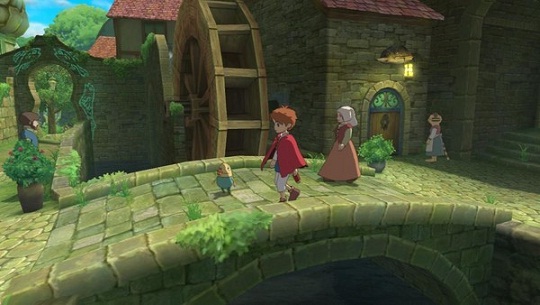
Q: What about escaping from battle and Game Over?
A: If you try to escape and fail, your whole party stands still and can’t select any commands for a few seconds, during which the enemies will do their best to make you pay. I haven’t been keeping track officially, but I feel like I have about a 50-50 chance of escaping when I try it.
When a game over happens (and it will happen to you), you’ll get the option of going back to the title screen or resuming from the approximate point where you died, with all of your EXP and items intact. The latter will cost 10% of your money, though.
Q: About how long is the game?
A: The main story will take most people 40, then more depending on how much treasure hunting, monster catching, leveling, world map exploration, and questing that you do. If you want to do everything and find everything, you’re probably looking at somewhere North of 90 hours.
Q: I listened to some jackass podcast that said there was nothing to do in the game. Why would they say that?
A: Because they don’t know What’s Up. Yes, a certain podcast has made its rounds online, during which people express that Ni no Kuni‘s towns are empty and its world map is lifeless. This could not be more false. The world map is one of the deepest, most detailed, and most gorgeous in any RPG I’ve ever played — and this is the genre in which I spend the most time. There are treasures to seek of two kinds, simple items that regenerate after a time, and one-time discoveries that are usually a lot more desirable. There are even secret villages to discover. Those don’t have a whole lot in them (how would they remain a secret otherwise, huh?), but there are often treasure boxes, NPCs to talk to and get some more info about the world, and some will even give you quests.
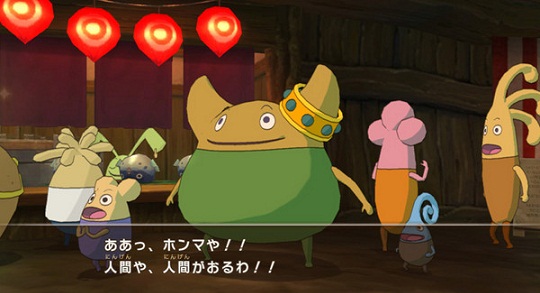
Q: Quests? Are these “fetch” quests?
A: No. When I hear “fetch quest,” I think of a guy saying “Hey can you go buy me a loaf of bread?” and then you bring him back some bread and he gives you 20 gold and a dagger. While there are quests in Ni no Kuni that fit this description, the majority do not (find an item, kill an enemy, raise a certain rare monster, alchemize something special, etc.). Moreover, the reward system is excellent. Not only do you get the rewards from the quest givers like one tends to expect from “fetch quests,” but each one is worth a certain number of stamps. Fill up a stamp card, and you can go to the nearest quest office (one in every town) and trade it in for rewards. These prizes include running slightly faster on the world map (good for escaping or for catching foes that try to run from you), EXP boosts, and more. It’s easy to become addicted to questing in this game.
If you strip away most games’ quests down to only the design mechanics, yeah, they all end up pretty similar, and I can see why some people might be quick to judge the questing system, especially when they don’t understand it. What I can tell you about Ni no Kuni‘s quests is this: as of my 33 hour playtime and as of my wife’s completion of the game, we both still have a lot of fun doing the quests and filling up my quest stamp cards. The system is set up very well.
Q: TOWNZ!?
A: Yep. They’re big, colorful, and fun.
Q: World map?
A: Yes. It has an incredible amount of detail and is worth exploring. If you ever, at any time, enjoyed running around an overworld in a Dragon Quest, Final Fantasy, Suikoden, Breath of Fire, or Wild ARMs game, you’ll love this world map.
THE POKEMON SECTION
Since there is monster catching in Ni no Kuni (which the latter calls “imajinns,” but we’ll say “monster” for simplicity), it gets a lot of Pokémon comparisons. Really, the comparison ends almost at the same point it begins: you catch monsters and they can evolve. That’s about all they have in common. Pokémon, however, is a game about catching and raising monsters, whereas Ni no Kuni is far from it. Ni no Kuni is a game about a boy venturing into a parallel world and trying to save it and his own at the same time, all the while trying to save his dead mother. Final Fantasy VII is not a game about shiny magic balls, it just has them in it; Catherine is not a game about sheep, it just has a lot of sheep in it; Breath of Fire isn’t about changing into dragons, that’s just a key battle mechanic; we could go on for days. It should be noted of course, just like the FFXII comparison above, that despite some similar features, playing Pokémon is nothing like playing Ni no Kuni. Having experience with one will not help you with the other.
In Pokémon, you beat on a monster until it’s weak, then throw a ball to *try* and catch it. Ni no Kuni starts with beating up an enemy like that, but you can’t just choose to catch any monster, they have to first show affection for your team, signaled by hearts over their heads. Then, the game’s leading lady Maru (called “Esther” in the English version) can use her charm ability to bring in the new recruit. There is a timer on this, but when used within the limit, it has 100% accuracy.
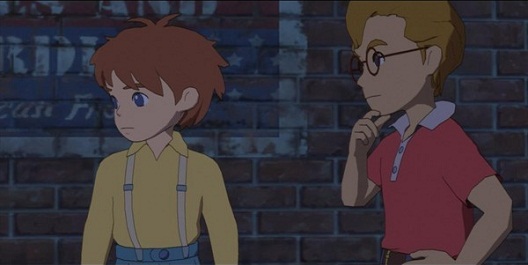
Evolution is also different than Pokémon. In Nintendo’s monster catcher, evolution is possible at certain levels, and then the player can choose to evolve them.
Skill learning:
Pokémon – With level, though certain forms of a monster will get skills earlier than other forms.
Ni no Kuni – Some monsters within the same evolution path can’t learn skills that others can, but you can *see* this beforehand, so you can avoid missing something that you think might be useful. You can also see ahead of time what your new stats will be when you evolve.
Levels and Stats:
Pokémon – Monsters maintain the same level when they evolve. Monsters higher on the evolution path tend to learn skills more slowly but have higher stats. You can’t see (as far as I remember) what skills you will and won’t learn or what your stats will be after you do evolve.
Ni no Kuni – Evolving a monster is done with consumable stones found in chests or dropped by enemies, and only after they’ve reached a minimum level. Choosing to evolve a monster will take its level back down to 1, but its base stats will be much better than the Lv. 1 version of its predecessor, and it may have a better growth rate to boot. This means that the Lv. 8 version of some monsters will be superior to the Lv. 18 versions of some others. The higher a monster’s stats at the time of evolution, then in general, the higher its new base is in the new Lv. 1 form. There may also be an impact on the growth rate.
Variety:
Pokémon – Monsters evolve on a straight path (with the exception of Eevee). Pichu can only become Pikachu, and Pikachu can only become Raichu.
Ni no Kuni – Most monsters have only one option for their first evolution, but after that, they can take a different path. You might want to catch a few of certain monsters so that you can explore both paths, because once you evolve up, there is no going backwards (a trait shared by both games).
OK!
I hope I’ve covered everything. If you want some opinion on the matter, I’ll be reviewing the game on PSLS soon, and you can meanwhile check out my wife’s Ni no Kuni review. If you have more questions, fire away in the comments section and I’ll either answer them there or even add them to this feature. Thanks for reading! If you can’t wait till January, there’s always the import option for those willing to brave the Japanese language.
